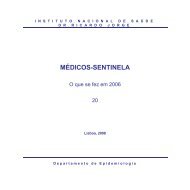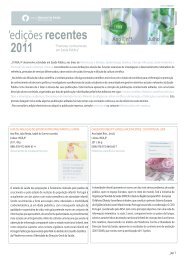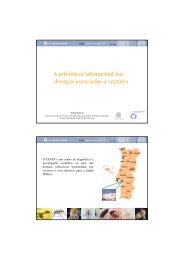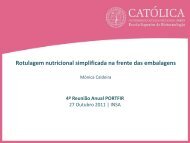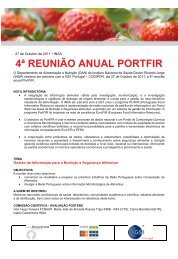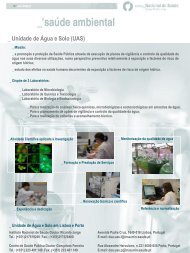European Society of Mycobacteriology - Instituto Nacional de Saúde ...
European Society of Mycobacteriology - Instituto Nacional de Saúde ...
European Society of Mycobacteriology - Instituto Nacional de Saúde ...
You also want an ePaper? Increase the reach of your titles
YUMPU automatically turns print PDFs into web optimized ePapers that Google loves.
A REPORT ON NEW ADAPTED FORMS OF EXTENSIVELY DRUG RESISTANCE<br />
TUBERCLE BACILLI : TRANSMISSION ELECTRON MICROSCOPY ANALYSIS<br />
OP-19<br />
Parissa Farnia(PhD)1. Ali Akbar Veleyati (MD)1, Mohammal Reza Masjedi (MD)1, 2 Tengku Azmi Ibrahim (PhD)2, Payam<br />
Tabarsei (MD), Rafiuz Zaman Haroun (MSC)2, Ho Oi Kuan (MSC))2, Abdul Rahman Omar (PhD)1<br />
1 - <strong>Mycobacteriology</strong> Research Centre, National Research Institute <strong>of</strong> Tuberculosis and Lung Disease (NRITLD), WHO<br />
Collaborating Centre, Shahid Beheshti University (Medical Campus), Darabad, Tehran ,19556, P.O: 19575/154, Iran.<br />
E-mail: pfarnia@hotmail.com<br />
2 - Microscopic unit, Institute <strong>of</strong> Bioscience , University Putra Malaysia ,43400 UPM ,Serdang, Selangor Darul Ehsan , Malaysia<br />
Background<br />
Extensively drug resistance tuberculosis bacilli (XDR-TB), is caused by a strain <strong>of</strong> M. tuberculosis(MTB) that are resistant to<br />
isoniazid and rifampin (which <strong>de</strong>fines MDR tuberculosis) in addition to any fluroquinolone and at least one <strong>of</strong> the three<br />
following injectable drugs: caperomycin, kanamycin and amikacin. Viewed un<strong>de</strong>r transmission electron microscopy (TEM),<br />
spore like structure was observed insi<strong>de</strong> the XDR-TB bacilli.<br />
Methods<br />
The susceptibility testing against first and second line drugs was performed on isolated M. tuberculosis strains. Subsequently,<br />
a homogenous thick suspension <strong>of</strong> 10 7 to 10 8 cells at exponential phase was prepared and observed un<strong>de</strong>r Transmission<br />
Electron Microscopy (TEM). Five isolates from each group (susceptible, MDR, and XDR TB) were used in this study.<br />
Results<br />
Viewed un<strong>de</strong>r the TEM, the XDRTB bacilli at exponential phase had three types <strong>of</strong> cell division 1) 80-70% <strong>of</strong> bacilli were<br />
looks as norm one with symmetrical or asymmetrical cell division 2) 5-7% with extra ordinary thick cell wall ( 21 to 26<br />
nm ) which was similar to stationary or dormant phase bacilli. But surprisingly the stationary phase XDR-TB bacilli were<br />
at dividing process 3) 15-20% bacilli had spore formation insi<strong>de</strong> them These spores were different from buds or a polar<br />
division that formed during cell branching <strong>of</strong> MTB. No spore’s and stationary phase bacilli were <strong>de</strong>tected in susceptible<br />
or multidrug resistant strains <strong>of</strong> MTB.<br />
Discussion<br />
Dividing phenomena in XDR-TB bacilli with stationary phase appearance will generate new adapted types <strong>of</strong> M. tuberculosis<br />
which can resist the effect <strong>of</strong> all available anti tuberculosis drugs. At the same time, it is possible that un<strong>de</strong>r certain<br />
conditions, the XDR-TB bacilli produce spore to overcome the hostile environment. Spore formation in XDR-TB bacilli<br />
should take very seriously from epi<strong>de</strong>miological point <strong>of</strong> view. With these new forms <strong>of</strong> adaptation that occurs in XDRTB<br />
bacilli , how should we treat and control the diseases.<br />
<strong>European</strong> <strong>Society</strong> <strong>of</strong> <strong>Mycobacteriology</strong> | 30 th Annual Congress | July 2009 | Porto - Portugal<br />
61



